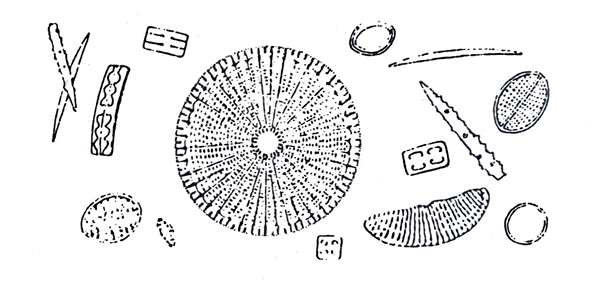Synonyms:
Agar-agar, Japanese Isinglass
Biological source:
Agar is the bleached and dried gelatinous substance obtained by concentrating a decoction made from various species of Gelidium and Gracilaria and other closely allied red algal seaweeds of the Class Rhodophyceae.
Geographical source:
Agar producing seaweeds grow abundantly along the eastern coast of Asia, particularly Japanese and South Korean coasts, and the western coast of North America.
 Fig. 69: Diatoms and sponge spicules from a specimen of Agar.
Fig. 69: Diatoms and sponge spicules from a specimen of Agar.
(Reproduced from Wallis)
Macroscopical and microscopical characters:
Agar occurs in colourless or yellowish translucent thin strips or flattened bands, about 50 to 60 cm long, 0.4 to 1.0 cm wide and 0.1 mm thick or about 30 cm long, 2.5 to 4 cm wide and 5 to 7 mm thick. The surface is micaceous and crinkled, and various species of diatoms (see Fig. 72) are found embedded in it. Agar is tough and difficult to break and has a slight odour and mucilaginous taste. It is insoluble in cold water, but swells to a gelatinous mass. On boiling with 100 parts of water Agar dissolves and yields a tiff jelly on cooling.
Chemical constituents:
The chief constituent of Agar is gelose, a calcium salt of the sulphuric ester of a carbohydrate complex. On acid hydrolysis gelose yields d-galactose, calcium and sulphate ions.
Uses:
Agar is extensively used as a bacterial culture medium. In pharmacy it is used as a suspending agent and a bulk laxative.

